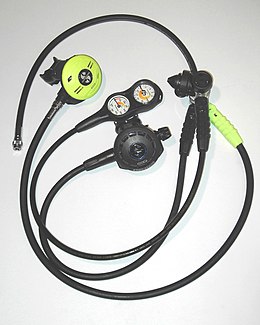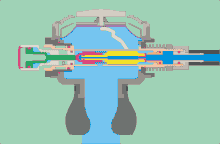Regulator

The regulator , including lung machine or shortly machine or controller called ( English regulator ), enables the breathing of an under pressure related breathing gas , also under water or in a toxic atmosphere. For this purpose, the breathing gas from the compressed air cylinder is reduced to the pressure in the environment by the regulator. Regulators are used in compressed air diving equipment , by rescue organizations and in medical technology.
The regulator used to consist of one stage. There are two levels in use today. The first stage ( pressure reducer ) reduces the cylinder pressure from mostly 200 to 300 bar to a mean pressure of around 4 to 12 bar (depending on the manufacturer) above the ambient pressure. The second stage then reduces the mean pressure to ambient pressure.
Development history
The first regulator was developed in 1942 and 1943 by Émile Gagnan at the suggestion of the well-known French marine researcher Jacques-Yves Cousteau and was named Aqualung . It was largely based on earlier technical concepts, such as by Georges Comeinhes and Rouquayrol-Denayrouze .
The first two-hose machines only had one pressure reducer stage, which reduced the cylinder pressure directly to ambient pressure. Since this control leads to a high valve control force, which the diver had to achieve by inhaling and the slight negative pressure generated by it, a two-stage principle was introduced soon afterwards. This two-stage lowering of the cylinder pressure to ambient pressure enables a much more sensitive setting of the valve that is actuated by the negative inhalation pressure. This increases breathing comfort. The mean pressure in the system is typically around 8 bar above ambient pressure. Based on the construction principle of the one-stage machine, the first two-stage machines were also arranged in a housing directly on the compressed air cylinder valve.
The air inside this one housing is first regulated down to medium pressure and then directly to ambient pressure. This air at ambient pressure was then fed from the machine through two soft, non-pressure-resistant rubber bellows hoses to a mouthpiece. The air flow in these two bellows hoses was controlled by one-way valves in such a way that the inhaled air was supplied through one hose and the exhaled air was discharged through the other hose to the back of the regulator, where it was blown into the surrounding water in the housing and through Openings could escape freely. Since two uniform bellows hoses led from the mouthpiece to the machine with this type, this type was called a two-hose machine. These two voluminous bellows hoses have long defined the typical image of a diver.
This principle of two hoses had the advantages that the mouthpiece was very light and that no disturbing bubbles rose in front of the diver's mask. This was particularly popular with underwater photographers and filmmakers. The main disadvantage was that the second stage could only regulate down to the ambient pressure at which the machine was located, and not to the ambient pressure of the mouthpiece. As a result, there was a significantly higher air pressure at the mouthpiece when the regulator was a little lower, and conversely, a clearly noticeable negative pressure when the regulator was higher. When diving, this had the effect that the diver's lungs were almost inflated on the ascent, while one had to suck heavily when diving (upside down).
For this reason, this construction principle has not caught on. The second stage was integrated into the mouthpiece so that the breathable air is supplied with the pressure that prevails in the immediate vicinity of the mouth. Since these machines only one hose, the medium-pressure hose leading to the mouthpiece, this guy Einschlauchautomat called. One-hose machines also offer a push button on the front of the device to manually override the valve between medium pressure and ambient pressure and thus activate the so-called air shower. You can blow out the mouthpiece or z. B. inflate a lift bag .
functionality

The prevailing construction principle consists of the following elements:
The first stage ( pressure reducer ) is connected directly to the valve on the compressed air cylinder. Two types of bottle connections are common, the so-called DIN (threaded outlet connection; internationally standardized according to DIN EN 144-2 / 3 and ISO 12209-2 ) and the so-called INT connection (bracket outlet connection; internationally standardized according to ISO 12209- 3 ). The first stage has at least one medium pressure connection (MD; English LP for Low Pressure ) for the second stage. Mostly, however, it has additional MD connections, e.g. B. for a so-called octopus (an additional second stage) and for connecting the inflator of the buoyancy compensator . (HD; English additionally at least one high pressure port is HP for High Pressure ) for the pressure gauge in place to be able to determine in the bottle to the residual pressure and the remaining breathing gas supply. The first stage consists of chrome-plated brass , stainless steel or titanium .
The second stage, which is connected to the first stage via a medium pressure hose (MD), is either also made of metal (brass, stainless steel), of plastic or a combination of both materials. It is the part of the machine that is located directly in front of the mouth and supplies the wearer with breathing gas via a mouthpiece.
The pressure in the medium pressure hose is initially closed off in the second stage via a spring-loaded valve. The spring force is set so that the valve just stays closed. A small rocker arm on the valve can open it with light actuation. This rocker arm is operated by a membrane that compares the ambient pressure with the pressure in the mouthpiece. If the wearer inhales, he creates a negative pressure in the mouthpiece in relation to the surroundings. This moves the membrane out of its rest position, the valve of the second stage opens via the rocker arm, and breathing gas flows into the mouthpiece - the user can breathe in. This membrane control ensures that the provided pressure of the breathing gas always adapts to the pressure of the environment and thus enables easy breathing. In the case of divers, the chest would otherwise have to work against the water pressure, which increases with the diving depth, when inhaling, which would make inhalation impossible even at a diving depth of a few meters.
Exhaling is made possible through another valve on the second stage. This usually consists of a thin rubber or silicone membrane, which in its rest position lies in front of the blow-out hole and seals it. Damage to this membrane can lead to the surrounding medium flowing into the oral cavity and lungs when inhaled, which can be disruptive or even life-threatening depending on the amount and medium (inhalation of water, inhalation of toxic gases).
Two other functions that are important for divers can also be integrated into the second stage: the bubble deflector and the air shower. The bladder deflector is an enlarged outlet of the exhalation valve that has been moved to the side. This means that the exhaled air escapes to the side behind the diving mask and does not flow through the field of vision. The air shower consists of a button on the housing that can be used to manually press the inhalation membrane. This causes air to flow through the second stage and the mouthpiece. If the mouthpiece is held in the mouth, the excess air escapes through the exhalation valve and thereby carries away any water in the second stage. The air shower is also used to fill lift bags and signal buoys with air underwater.
With modern diving equipment, at least the following four accessories are usually connected to the first stage:
- The second stage
- The octopus - another second tier as an emergency replacement for the user or a diving buddy.
- One or more inflator hoses for the buoyancy compensator (jacket) and / or the dry suit . These enable the diver to tare in the water . So he can adjust the static buoyancy positive, negative or neutral.
- The pressure gauge - a manometer that shows the diver the cylinder pressure and thus the remaining air supply in the cylinder. The pressure gauge can be combined in a console with other instruments, for example with a depth gauge , compass and dive computer .
Regulators are designed fail-safe ( Fail-Safe ) . If they fail, do not cut off the air supply. In this case, you let the air flow out continuously.
variants
The regulator for compressed air breathing apparatus , as it is also used by the fire brigade , differs in appearance from that for divers, but fulfills the same function. Here the regulator is not put in the mouth, but screwed directly onto the respirator . Full face diving masks are also used for fire service divers. The exhalation valve is integrated in the regulator. There is a normal pressure and an overprint technique. With the normal pressure technique, the air pressure in the mask corresponds approximately to the ambient pressure; With the overpressure technique it is slightly above the ambient pressure in order to prevent the penetration of toxic gases in the event of a (even only temporary) leak in the mask. The disadvantage is, on the one hand, that air escapes into the environment. On the other hand, the necessary exhalation pressure increases because the exhalation valve, which receives the overpressure, has to be overcome. There are device types in which the warning device is integrated in the regulator.
Medical regulators are used in medical technology when it comes to ventilation with certain breathing gases or performance diagnostics.
See also
literature
- Werner Scheyer: "regulator". Technology and function of the regulators. Verlag Stephanie Naglschmid, Stuttgart 1991, ISBN 3-925342-47-8 .
Web links
- Michael Böhm: Regulators - basic information for beginners . In: DiveInside , No. 1/2007 (PDF; 747 kB).
- Werner Scheyer, Jan Maier: Regulator - structure and function . Association of international diving schools / diving club UniDive e. V. ( PPT ; 3.2 MB).
References and comments
Remarks
- ↑ In cold waters (water temperature below 10 ° C), German diving associations in particular recommend using two completely separate regulators, each with their own cylinder valves and first stages, due to the risk of the regulator freezing. However, this assumes that the diver is able to operate the cylinder valves quickly and independently under all conditions, which is mainly taught and trained in the field of technical diving . When scuba diving in the range up to max. 30 meters and without decompression obligations , on the other hand, the standard procedure is to emerge with the air flowing out of the defective regulator and possibly the octopus of the diving partner in the event of a failure of the regulator (venting regulator) and thus to safely end the dive.
Individual evidence
- ↑ Michael Jung: regulator history. Technical history of the demand-controlled regulator for compressed air diving equipment. Merzig, 2000, ISBN 3-933234-05-0 .




